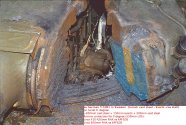Italian La Repubblica: The United States and NATO allow the start of peace talks on Ukraine in the event that Kiev recaptures Kherson, the battle for which has both strategic and diplomatic significance.
Automatic translation from Italian:
Take Kherson and then negotiate: NATO now sees a window
Automatic translation from Italian:
Take Kherson and then negotiate: NATO now sees a window
Confidential reports between Washington and Brussels identify a short-term negotiating window: reach all the way to the banks of the Dnipro and push for a ceasefire from a position of strength.
BRUSSELS - Negotiate. Even in the short term. When the advantageous position will be evident. After the recapture of the southern city of Kherson, where one of the toughest battles against the Russian army is being fought. In the latest analyses circulating in the NATO offices in Brussels, the confrontation in that area is taking on a value that is not only strategic from a military point of view. But also from a political and diplomatic one. And it is mainly the U.S. that is conveying to the allies the possibility of a breakthrough. Because beating the Russian army in one of the most important gateways to the Sea of Azov and Crimea can mean a real chance to engage in the first real negotiations with Moscow.
Indeed, in the reports circulating between Atlantic Alliance officials and EU interlocutors, one assumption is made: the Russian armies are now under pressure. Unable to react successfully to the Ukrainian advance. Their reaction is focused defensively on destroying infrastructure - power grid, water supply, bridges, roads -, building a triple line of trenches and using natural barriers such as the Dnipro River. The goal is to slow the advance of Kiev troops. Kherson is not just any town: decisive for access to the sea and crucial for control of water resources and river transport. Recapturing it would mean permanently changing the direction of the conflict.
Precisely for this reason, a message is coming from the U.S.-through Brussels-that is also an invitation to the Ukrainian government: if and when Kherson is recaptured, then negotiations can begin. From a position of strength and not weakness. The point is that the White House for the first time has begun to speculate on such a concrete path. Not without Kherson, however. Not now. Not least because starting negotiations at this stage would only mean giving Moscow's military time to reorganize. Some strategic cornerstones must, in short, be consolidated first. To then discuss having the upper hand. This is also why Washington and NATO have confirmed to Zelensky the forthcoming dispatch of more missiles with a range capable of inhibiting the action of Iranian-built drones. More weapons, therefore, will arrive in Kiev precisely with the goal of reaching the Kherson target.
What is more, there are two key aspects that the U.S. Administration is emphasizing in now-daily exchanges with NATO allies. The first concerns the Russian threat of the use of tactical nuclear bombs. While this is considered a form of deterrence that is not currently active, it remains a risk to be avoided. Not least because in that case not only would there almost inevitably be a wide-ranging reaction with conventional weapons, but it would become difficult to contain the nervousness of some allies such as the Poles, who now represent the EU's closest partner militarily to Washington (indeed, some reaction schemes involve precisely the deployment of Warsaw's troops). The other concerns relations with China. Having lost Kherson, the crisis in the former Red Army would be over. The solutions hypothesized a few months ago in connection with a possible "regime change" in the Kremlin have now been overcome. At this point, for the United States, the total defeat of Putin would result in a worse consequence: handing over control of Russia to China. It would be like going from the frying pan into the fire. Better, then, a hostile but bruised leader independent of Beijing.
Of course, American plans for dialogue also depend on political factors: the first will take shape next week with the midterm elections. The possibility of the Democrats losing their majorities in both the Senate and the House (and the widespread victory of Trumpian candidates) may have different effects. Just as it is not yet clear whether the Biden-Putin talks at the G20 in Bali will take place. The war however enters a different phase thanks to a kind of "parellela convergence" of Kremlin and White House interests. A negotiation may certainly not lead immediately to peace but perhaps to a cease-fire in the Donbass. And also to the extension of the grain agreement.


